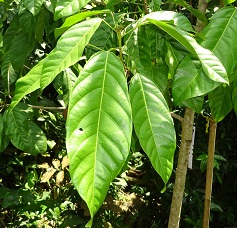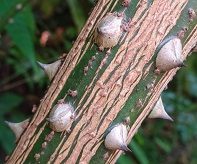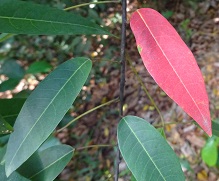| Home | Nature Weekly Index |
26 July 2015 | Walk at the Park (Part 1) | Admiralty Park |
I made my way to Admiralty Park around noon yesterday. It was a really hot day. The last time I came by was in January. That was the time when many of the new trees were planted and one of the bridge that cross the river was still being refurbished. Now, the bridge was opened for visitors and most of the planted trees were looking healthy.

 Of the trees planted, there were 2 Sterculia species, namely
Sterculia parviflora and
Sterculia cordata. It was
easy to identify them since they still had their name tags on. Sterculia parviflora was also a tree commonly planted along
the roadside, at least in the north. I had previously thought that it was Sterculia oblongata. The main visible different
between the 2 Sterculia species when they were not flowering or fruiting was the size of their leaves. Matured leaves of
Sterculia cordata is generally much larger than that of Sterculia parviflora.
Of the trees planted, there were 2 Sterculia species, namely
Sterculia parviflora and
Sterculia cordata. It was
easy to identify them since they still had their name tags on. Sterculia parviflora was also a tree commonly planted along
the roadside, at least in the north. I had previously thought that it was Sterculia oblongata. The main visible different
between the 2 Sterculia species when they were not flowering or fruiting was the size of their leaves. Matured leaves of
Sterculia cordata is generally much larger than that of Sterculia parviflora.
 The 4 Leea angulata shrubs were thriving. They were much bushier than the last time
I saw them back in January. In addition, they were flowering and fruiting. The prominent feature of Leea angulata when
compared to the rest of the Leea species in Singapore was the large thorns found on its stems.
The 4 Leea angulata shrubs were thriving. They were much bushier than the last time
I saw them back in January. In addition, they were flowering and fruiting. The prominent feature of Leea angulata when
compared to the rest of the Leea species in Singapore was the large thorns found on its stems.
 There was a lone Triadica cochinchinensis tree along the side of a track.
This tree was unlikely to be planted by NPark. I had seen it when it was still a young plant. The unique feature of this tree was
the matured reddish leaves when they were about to drop off. This phenomenon was also exhibited by the
Penang Sloe (Kopsia arborea).
There was a lone Triadica cochinchinensis tree along the side of a track.
This tree was unlikely to be planted by NPark. I had seen it when it was still a young plant. The unique feature of this tree was
the matured reddish leaves when they were about to drop off. This phenomenon was also exhibited by the
Penang Sloe (Kopsia arborea).
The most interesting tree planted was Pelir Musang (Fagraea auriculata). This was a critically endangered plant in Singapore and grew on coastal cliffs. More information on this native plant is available in the publication by Yeo et al (2011). Another new plant cultivated was Bird Lime Tree (Cordia dichotoma). There were several young treelets planted at an open space in an effort to reforest the area. I recalled reading about this native plant some years back from a blog post by Joseph Lai in 2008. Joseph used to have a wonderful website on local native plants known as EARTH which I visited often in the past.
Though it is heartening to see that we are bringing back these native trees and striving to preserve whatever wild places that are left, the continuous development of the surrounding area for residential and commercial purposes will continue to put pressure on the survival of nature's residents in this park.